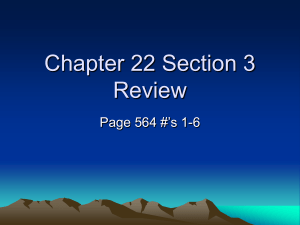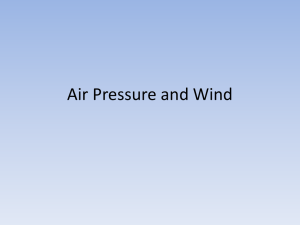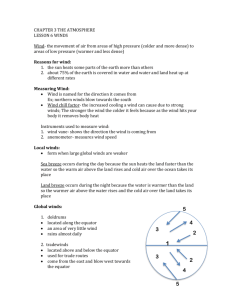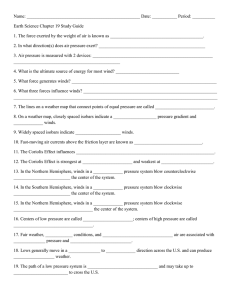Handout 3.1
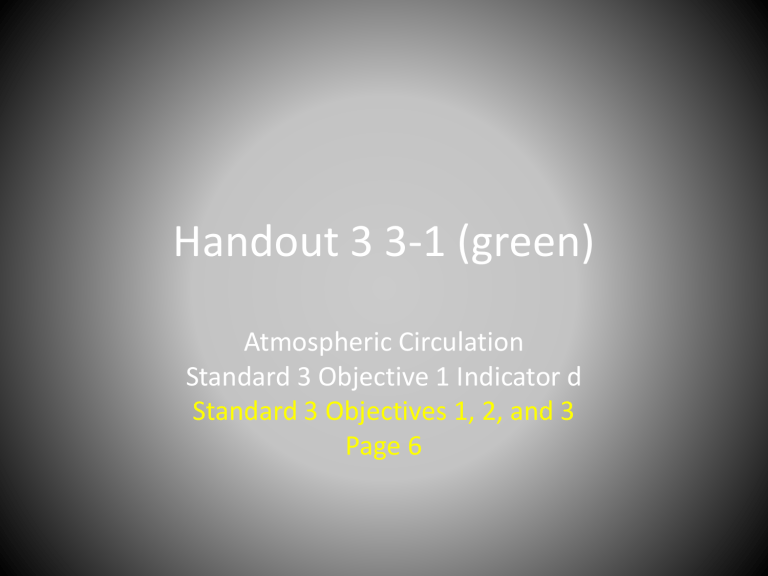
Handout 3 3-1 (green)
Atmospheric Circulation
Standard 3 Objective 1 Indicator d
Standard 3 Objectives 1, 2, and 3
Page 6
1. What causes the movement of air worldwide?
• Pressure differences in the atmosphere
2. Why does air near Earth’s surface flow from the poles to the equator?
• Air moves form high-pressure to regions to lower-pressure regions
3. Where do low-pressure regions form?
• Where warm air rises away form Earth’s surface
4. What is the circulation of the atmosphere and of the oceans affected by?
• The rotation of Earth on its axis
5. Why does air follow a curved path?
• When air moves toward the poles it travels
East faster then the land beneath it. As a result, the air follows a curved path
6. The curving of the path of a moving object from an otherwise straight path due to earth’s rotation is called the
7. In which direction does the Coriolis effect deflect moving objects in the Northern
Hemisphere? And in the Southern Hemisphere?
• Objects are deflected to the right in the Northern
Hemisphere and to the left in the Southern
Hemisphere.
8. What are the three looping patterns of air flow in each hemisphere called?
• Convection cells
9. The prevailing winds that blow from east to west from 30° latitude to the equator in both hemispheres are
10. What are the prevailing winds that blow from west to east through the
United States called?
• Westerlies
11. What are the prevailing winds that blow from east to west between 60° and 90° in both hemispheres?
• The Polar Easterlies
12. doldrums
13. horse latitudes
14. jet streams
15.
subtropical jet streams
Matching 12-15
a. narrow bands of winds formed when warm equatorial air meets the cooler air of the middle latitudes b. narrow bands of strong winds that blow in the upper troposphere c. a zone of low pressure at the equator where the trade wind systems meet d. subtropical high-pressure zones with weak and variable winds
16. Air movement influenced by local conditions and local temperature variations often cause
Local winds wind belts.
17. As warm air above land rises and cool air from above water moves in to replace it, a cool wind moving from water to land, called a
Sea breeze
18. At night, as warm air above water rises and cool air from above land moves out to replace it, a cool wind moving from land to water, called
19. During the day in mountainous regions, a when warm air from the valleys moves.
20. Explain how the Coriolis Effect affects wind flow.
• The Coriolis effect causes wind to curve because wind is blowing at a different speed then the ground beneath it.
• Northern Hemisphere = Winds curve to the right
• Southern Hemisphere = Winds curve to the left
Coriolis Effect
21. Name and describe Earth’s three global wind belts.
• Polar easterlies: winds that blow from east to west between 60 o and 90 o latitude in both hemispheres.
• Westerlies: winds that blow from west to east between 30 o and 60 o (middle latitudes) in both Hemispheres.
• Trade winds: winds that blow from east to west between 30 o and the equator in both
Hemispheres.
Major Wind Belts
22. Summarize the importance of the jet streams.
• The are important because they can affect the paths of storms and airline routes.
23. Identify two factors that create local wind patterns.
• Temperature differences between land and sea and between mountains and valleys influence local wind patterns
24. Determine whether wind moving south from the equator will curve eastward or westward because of the
Coriolis Effect.
• Wind moving southward form the equator will curve to the east because of the Coriolis effect.

